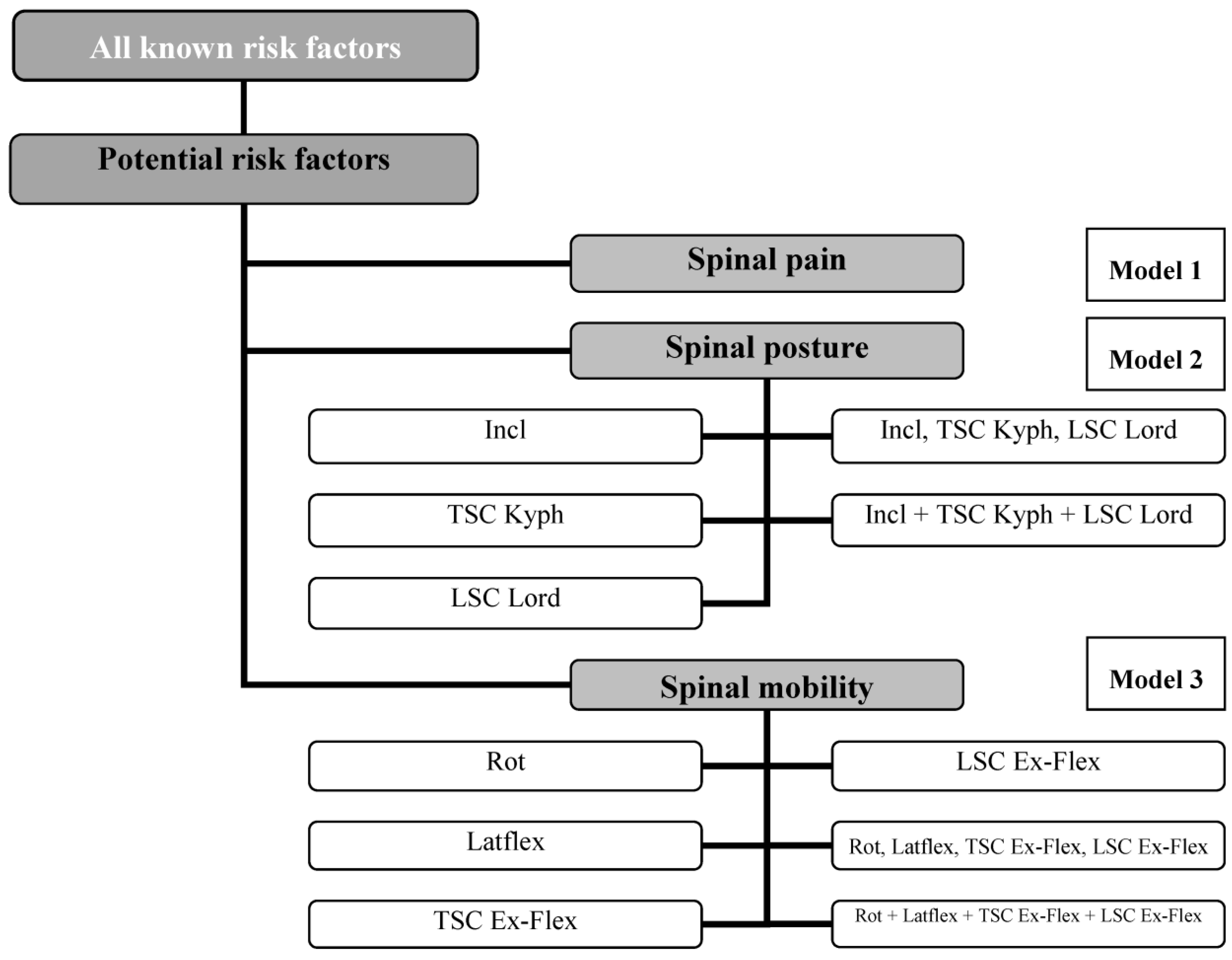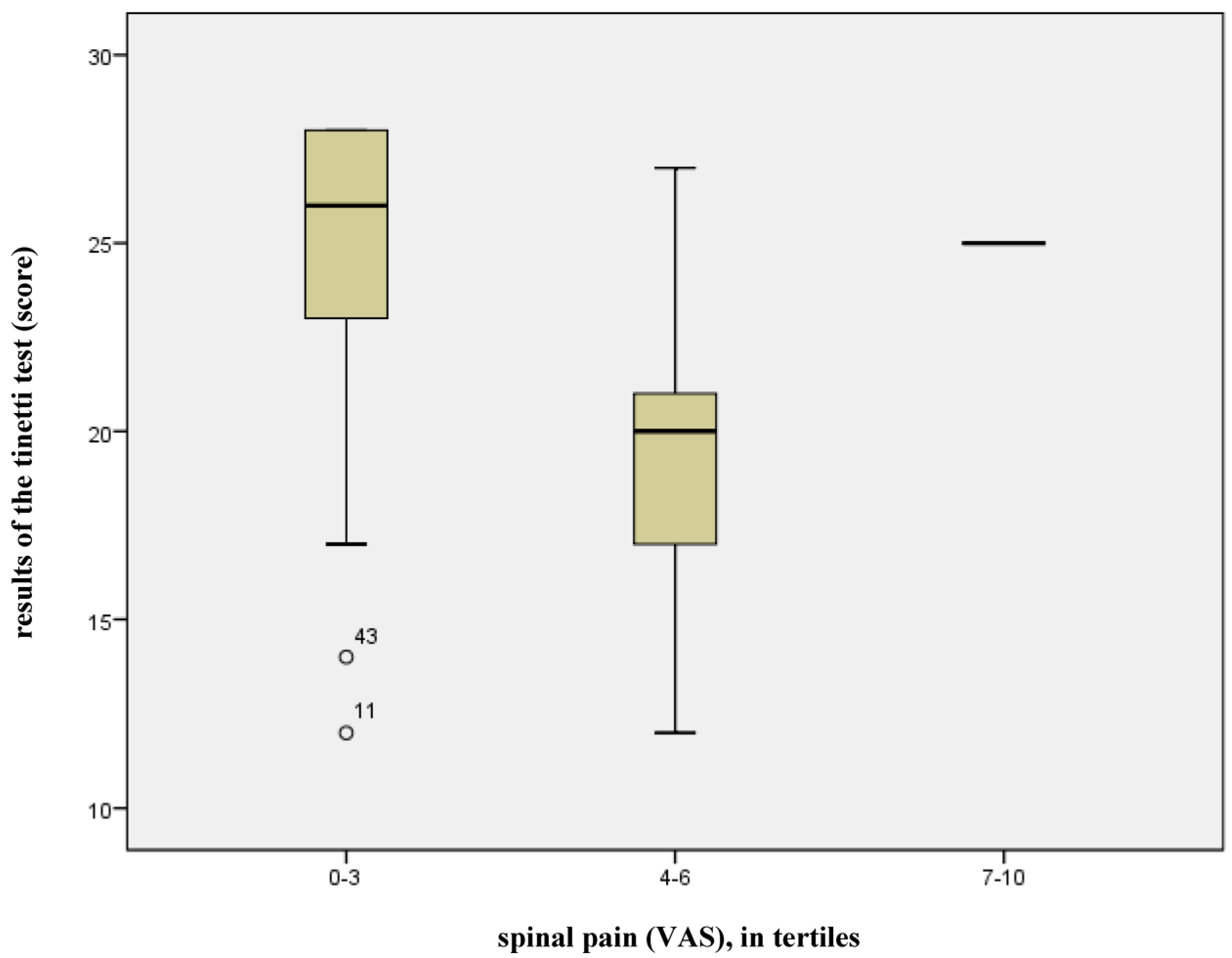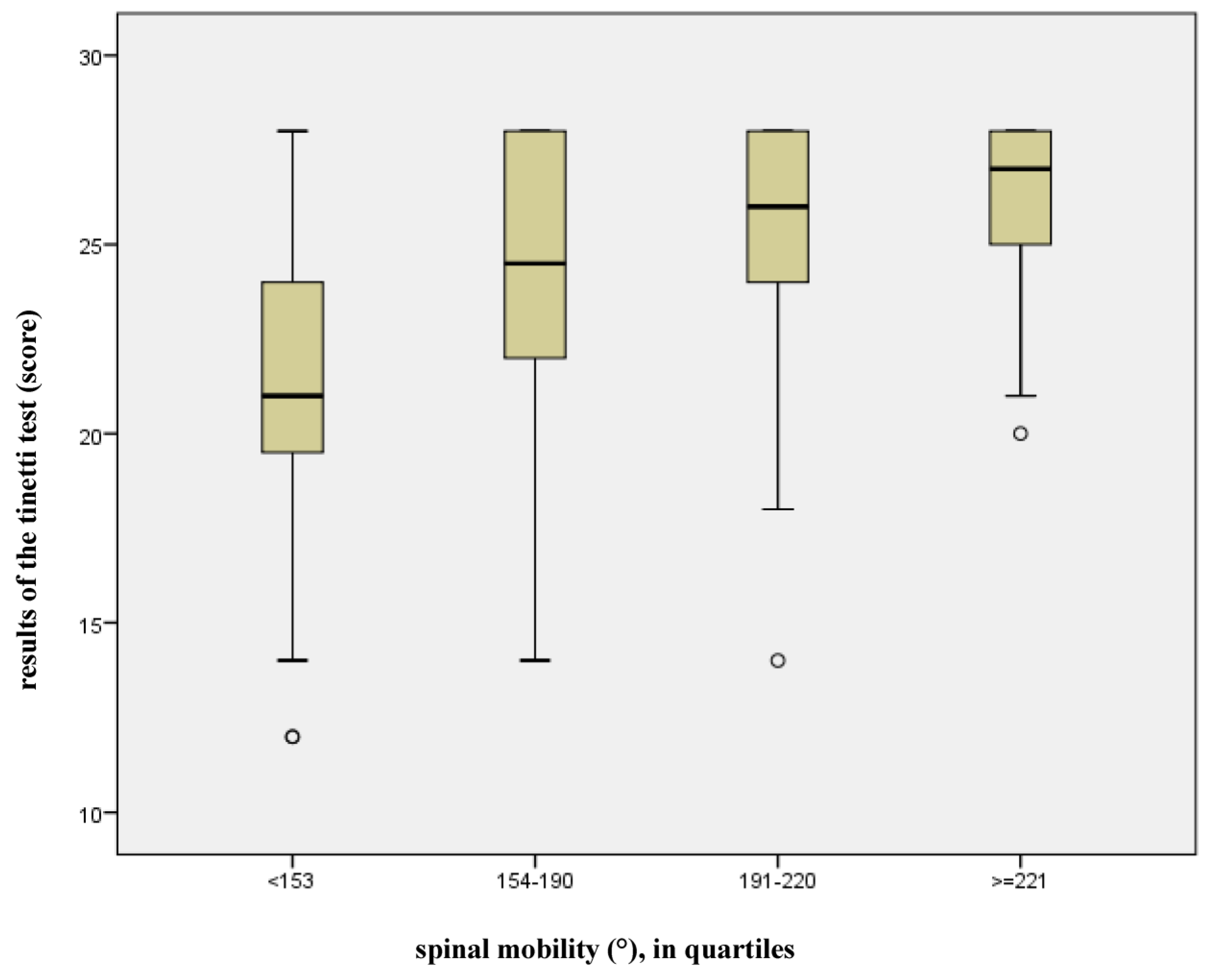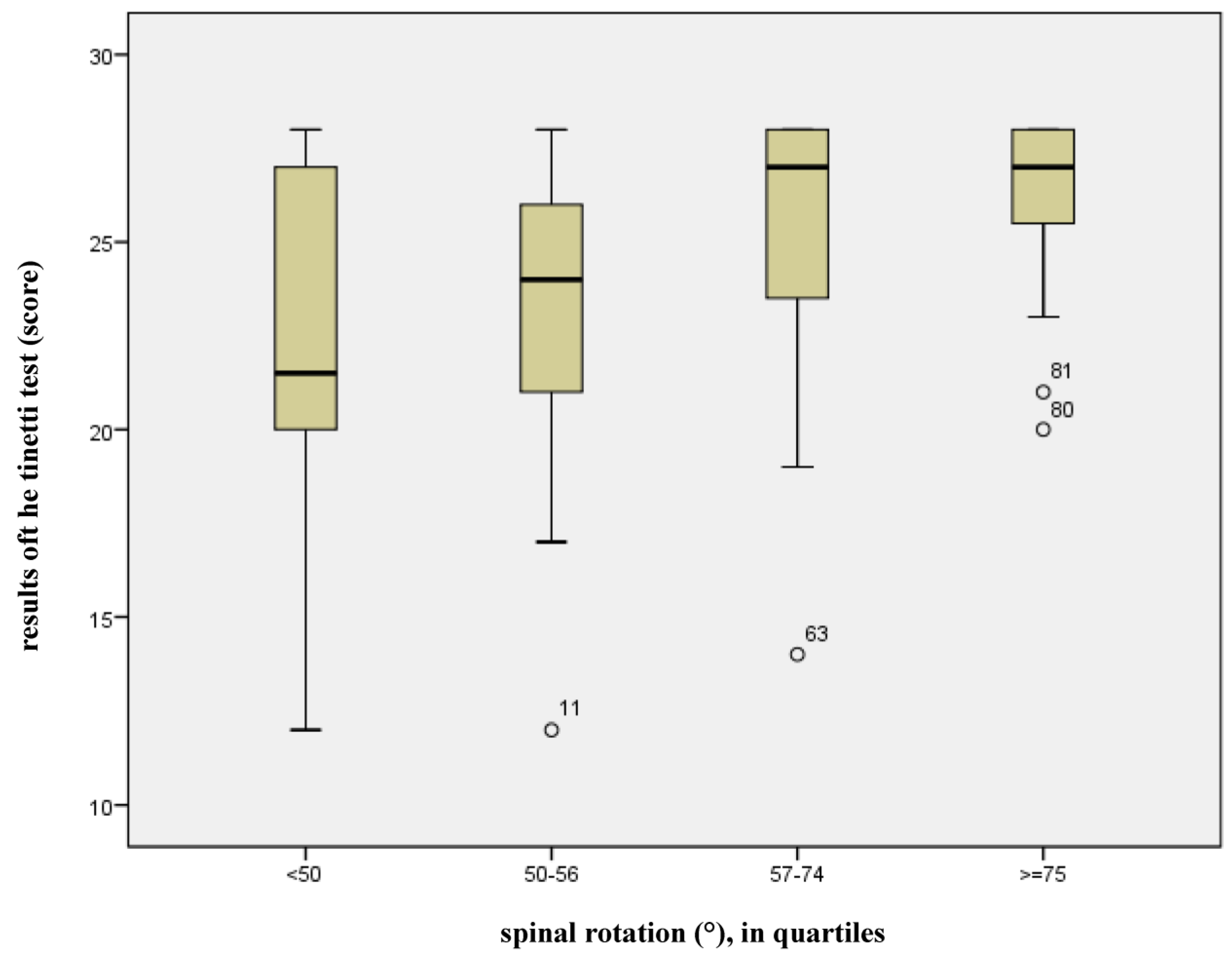The Influence of Spinal Pain, Spinal Mobility, and Spinal Curvature on the Risk of Falling in Osteoporotic Patients
Abstract
1. Introduction
2. Materials and Methods
2.1. Subject Group
2.2. Consideration of Risk Factors Already Acknowledged in Previous Studies
2.3. Determination of the Risk of Falling
2.4. Statistical Analysis
- 1.
- Does back pain influence the risk of falling in osteoporotic patients?
- 2.
- Does spinal curvature (inclination) influence the risk of falling in osteoporotic patients?
- 3.
- Does spinal mobility (rotation, lateral flexion, extension, ventral/dorsal flexion) influence the risk of falling in osteoporotic patients?
3. Results
4. Discussion
5. Conclusions
Author Contributions
Funding
Institutional Review Board Statement
Informed Consent Statement
Data Availability Statement
Conflicts of Interest
References
- Robert Koch-Institut 2024 Stürze (ab 65 Jahre). Gesundheitsberichterstattung Des Bundes. Available online: https://gbe.rki.de (accessed on 12 June 2025).
- Rubenstein, L.Z.; Josephson, K.R. The epidemiology of falls and syncope. Clin. Geriatr. Med. 2022, 18, 141–158. [Google Scholar] [CrossRef] [PubMed]
- Tinetti, M.E.; Williams, T.F.; Mayewski, R. Fall risk index for elderly patients based on number of chronic disabilities. Am. J. Med. 1986, 80, 429–434. [Google Scholar] [CrossRef] [PubMed]
- Boehm, K.; Tesch-Roemer, C.; Ziese, T. Gesundheit und Krankheit im Alter. Eine gemeinsame Veröffentlichung des Statistischen Bundesamtes, des Deutschen Zentrums für Altersfragen und des Robert Koch-Instituts. Gesundheitsberichterstattung Des Bundes 2009. [Google Scholar] [CrossRef]
- Panel on Prevention of Falls in Older Persons, A.G.S.a.B.G.S. Summary of the Updated American Geriatrics Society/British Geriatrics Society clinical practice guideline for prevention of falls in older persons. J. Am. Geriatr. Soc. 2011, 59, 148–157. [Google Scholar] [CrossRef]
- Peng, K.; Tian, M.; Andersen, M.; Zhang, J.; Liu, Y.; Wang, Q.; Lindley, R.; Ivers, R. Incidence, risk factors and economic burden of fall-related injuries in older Chinese people: A systematic review. Inj. Prev. J. Int. Soc. Child Adolesc. Inj. Prev. 2019, 25, 4–12. [Google Scholar] [CrossRef]
- DVO. DVO-Leitlinie. Prophylaxe, Diagnostik und Therapie der Osteoporose bei Postmenopausalen Frauen und bei Männern ab dem 50.Lebensjahr. 2023. Contract No.: AWMF-Register-Nr.: 183/001. V2.1: 1-420. Available online: https://register.awmf.org/de/leitlinien/detail/183-001 (accessed on 27 May 2025).
- Brech, G.C.; Plapler, P.G.; de Souza Meirelles, E.; Marcolino, F.M.; Greve, J.M. Evaluation of the association between osteoporosis and postural balance in postmenopausal women. Gait Posture 2013, 38, 321–325. [Google Scholar] [CrossRef]
- Sanfelix-Genoves, J.; Sanfelix-Gimeno, G.; Peiro, S.; Hurtado, I.; Fluixa, C.; Fuertes, A.; Campos, J.C.; Giner, V.; Baixauli, C. Prevalence of osteoporotic fracture risk factors and antiosteoporotic treatments in the Valencia region, Spain. The baseline characteristics of the ESOSVAL cohort. Osteoporos. Int. 2013, 24, 1045–1055. [Google Scholar] [CrossRef]
- Smith, E.M.; Shah, A.A. Screening for Geriatric Syndromes: Falls, Urinary/Fecal Incontinence, and Osteoporosis. Clin. Geriatr. Med. 2018, 34, 55–67. [Google Scholar] [CrossRef]
- Hubscher, M.; Vogt, L.; Schmidt, K.; Fink, M.; Banzer, W. Perceived pain, fear of falling and physical function in women with osteoporosis. GaitPosture 2010, 32, 383–385. [Google Scholar] [CrossRef]
- Kato, S.; Murakami, H.; Demura, S.; Yoshioka, K.; Shinmura, K.; Yokogawa, N.; Igarashi, T.; Yonezawa, N.; Shimizu, T.; Tsuchiya, H. Abdominal trunk muscle weakness and its association with chronic low back pain and risk of falling in older women. BMC Musculoskelet Disord 2019, 20, 273. [Google Scholar] [CrossRef]
- Stubbs, B.; Binnekade, T.; Eggermont, L.; Sepehry, A.A.; Patchay, S.; Schofield, P. Pain and the risk for falls in community-dwelling older adults: Systematic review and meta-analysis. Arch. Phys. Med. Rehabil. 2014, 95, 175–187.e179. [Google Scholar] [CrossRef] [PubMed]
- World Health Organization. Prevention and Management of Osteoporosis: Report of a WHO Scientific Group; WHO Scientific Group on the Prevention and Management of Osteoporosis: Geneva, Switzerland, 2000; p. 192. Available online: https://apps.who.int/iris/handle/10665/42841 (accessed on 16 May 2012).
- Washburn, R.A.; Smith, K.W.; Jette, A.M.; Janney, C.A. The Physical Activity Scale for the Elderly (PASE): Development and evaluation. J. Clin. Epidemiol. 1993, 46, 153–162. [Google Scholar] [CrossRef] [PubMed]
- Bischoff, H.A.; Stahelin, H.B.; Monsch, A.U.; Iversen, M.D.; Weyh, A.; von Dechend, M.; Akos, R.; Conzelmann, M.; Dick, W.; Theiler, R. Identifying a cut-off point for normal mobility: A comparison of the timed 'up and go' test in community-dwelling and institutionalised elderly women. Age Ageing 2003, 32, 315–320. [Google Scholar] [CrossRef] [PubMed]
- Mannion, A.F.; Knecht, K.; Balaban, G.; Dvorak, J.; Grob, D. A new skin-surface device for measuring the curvature and global and segmental ranges of motion of the spine: Reliability of measurements and comparison with data reviewed from the literature. Eur. Spine J. 2004, 13, 122–136. [Google Scholar] [CrossRef]
- Bistritschan, E.; Delank, S.; Winnekendonk, G.; Eysel, P. Oberflächenmessverfahren (Medimouse) versus Röntgenfunktionsaufnahmen zur Beurteilung der lumbalen Wirbelsäulenbeweglichkeit. Z. Für Orthopädie 2003, 141. [Google Scholar] [CrossRef]
- Audette, I.; Dumas, J.P.; Cote, J.N.; De Serres, S.J. Validity and between-day reliability of the cervical range of motion (CROM) device. J. Orthop. Sports Phys. Ther. 2010, 40, 318–323. [Google Scholar] [CrossRef]
- Fletcher, J.P.; Bandy, W.D. Intrarater reliability of CROM measurement of cervical spine active range of motion in persons with and without neck pain. J. Orthop. Sports Phys. Ther. 2008, 38, 640–645. [Google Scholar] [CrossRef]
- Stanghelle, B.; Bentzen, H.; Giangregorio, L.; Pripp, A.H.; Bergland, A. Associations between health-related quality of life, physical function and pain in older women with osteoporosis and vertebral fracture. BMC Geriatr 2019, 19, 298. [Google Scholar] [CrossRef]
- Ishikawa, Y.; Miyakoshi, N.; Kasukawa, Y.; Hongo, M.; Shimada, Y. Spinal sagittal contour affecting falls: Cut-off value of the lumbar spine for falls. Gait Posture 2013, 38, 260–263. [Google Scholar] [CrossRef]
- Katzman, W.B.; Vittinghoff, E.; Ensrud, K.; Black, D.M.; Kado, D.M. Increasing kyphosis predicts worsening mobility in older community-dwelling women: A prospective cohort study. J. Am. Geriatr. Soc. 2011, 59, 96–100. [Google Scholar] [CrossRef]
- Miyakoshi, N.; Hongo, M.; Maekawa, S.; Ishikawa, Y.; Shimada, Y.; Itoi, E. Back extensor strength and lumbar spinal mobility are predictors of quality of life in patients with postmenopausal osteoporosis. Osteoporos. Int. 2007, 18, 1397–1403. [Google Scholar] [CrossRef]
- Miyakoshi, N.; Kasukawa, Y.; Ishikawa, Y.; Nozaka, K.; Shimada, Y. Spinal alignment and mobility in subjects with chronic low back pain with walking disturbance: A community-dwelling study. Tohoku J. Exp. Med. 2010, 221, 53–59. [Google Scholar] [CrossRef] [PubMed]
- Hilliard, M.J.; Martinez, K.M.; Janssen, I.; Edwards, B.; Mille, M.L.; Zhang, Y.; Rogers, M.W. Lateral balance factors predict future falls in community-living older adults. Arch. Phys. Med. Rehabil. 2008, 89, 1708–1713. [Google Scholar] [CrossRef] [PubMed]
- Yang, W.C.; Hsu, W.L.; Wu, R.M.; Lu, T.W.; Lin, K.H. Motion analysis of axial rotation and gait stability during turning in people with Parkinson's disease. Gait Posture 2016, 44, 83–88. [Google Scholar] [CrossRef] [PubMed]
- Chiacchiero, M.; Dresely, B.; DeLosReyes, R. The Relationship Between Range of Movement, Flexibility, and Balance in the Elderly. Top. Geriatr. Rehabil. 2010, 26, 148–155. [Google Scholar] [CrossRef]
- Kasukawa, Y.; Miyakoshi, N.; Hongo, M.; Ishikawa, Y.; Noguchi, H.; Kamo, K.; Sasaki, H.; Murata, K.; Shimada, Y. Relationships between falls, spinal curvature, spinal mobility and back extensor strength in elderly people. J. Bone Miner. Metab. 2010, 28, 82–87. [Google Scholar] [CrossRef]




| Women n = 87 | Men n = 13 | Total n = 100 | ||
|---|---|---|---|---|
| Number of falls in the last 6 months | 0 fall | 62 (71.3%) | 8 (61.5%) | 70 |
| 1 fall | 18 (20.7%) | 3 (23.1%) | 21 | |
| 2 falls | 5 (5.7%) | 1 (7.7%) | 6 | |
| 4 falls | 1 (1.1%) | 1 (7.7%) | 2 | |
| 6 falls | 1 (1.1%) | 0 | 1 | |
| Use of walking aids | 10 (11.5%) | 1 (7.7%) | 11 | |
| Reduction in visus acuity | 33 (37.9%) | 2 (15.4%) | 35 | |
| Intake of medications (>4 per day) | 26 (29.9%) | 6 (46.2%) | 32 | |
| Fall-related drugs | 16 (18.4%) | 1 (7.7%) | 17 | |
| Level of activity * | level 1 | 11 (12.6%) | 0 | 11 |
| level 2 | 16 (18.4%) | 4 (30.8%) | 20 | |
| level 3 | 36 (41.4%) | 4 (30.8%) | 40 | |
| level 4 | 24 (27.6%) | 5 (38.5%) | 29 | |
| Spinal pain at the time of examination? | 30 (34.5%) | 2 (15.4%) | 32 | |
| Pain in the extremities at the time of examination? | 12 (13.8%) | 1 (7.7%) | 13 | |
| Dizziness at the time of examination? | 0 | 0 | 0 | |
| Other influencing factors at the time of examination? | 0 | 0 | 0 | |
| MV | SD | Range | Test Positiv | MV | SD | Range | Test Positiv | |
|---|---|---|---|---|---|---|---|---|
| All, n = 100 | Women, n = 87 | |||||||
| Chair-Rising Test (seconds) | 12.2 | 5.9 | 0–40 | 53% 1 | 12.2 * | 5.6 | 0–40 | 55.2% |
| Tandem Test (seconds) | 11.0 | 5.4 | 0–15 | 38% 2 | 11.1 * | 5.3 | 0–15 | 39.1% |
| Timed Up-and-Go Test (seconds) | 9.8 | 4.2 | 5–29 | 19% 3 | 9.8 * | 4.1 | 5–29 | 19.5% |
| Tinetti Test (score) | 24 | 4 | 12–28 | 4% 4 | 24 * | 4 | 12–28 | 19.5% |
| MV | SD | Range | MV | SD | Range | MV | SD | Range | |
|---|---|---|---|---|---|---|---|---|---|
| Women, n = 87 | Men, n = 13 | All, n = 100 | |||||||
| SC lateral flexion (degree) | 70 | 21 | 20–110 | 75 * | 28 | 15–122 | 70 | 22 | 15–122 |
| SC rotation (degree) | 57 | 19 | 20–115 | 62 * | 17 | 20–80 | 58 | 19 | 20–115 |
| TSC extension–flexion (degree) | 14 | 15 | −19–43 | 16 * | 14 | −2–53 | 14 | 14 | −19–53 |
| LSC extension–flexion (degree) | 44 | 18 | −12–78 | 41 * | 18 | 13–78 | 44 | 18 | −12–78 |
Disclaimer/Publisher’s Note: The statements, opinions and data contained in all publications are solely those of the individual author(s) and contributor(s) and not of MDPI and/or the editor(s). MDPI and/or the editor(s) disclaim responsibility for any injury to people or property resulting from any ideas, methods, instructions or products referred to in the content. |
© 2025 by the authors. Licensee MDPI, Basel, Switzerland. This article is an open access article distributed under the terms and conditions of the Creative Commons Attribution (CC BY) license (https://creativecommons.org/licenses/by/4.0/).
Share and Cite
Diegisser, A.; Huthwelker, J.; Konradi, J.; Bodem, F.; Drees, P.; Betz, U. The Influence of Spinal Pain, Spinal Mobility, and Spinal Curvature on the Risk of Falling in Osteoporotic Patients. J. Clin. Med. 2025, 14, 4511. https://doi.org/10.3390/jcm14134511
Diegisser A, Huthwelker J, Konradi J, Bodem F, Drees P, Betz U. The Influence of Spinal Pain, Spinal Mobility, and Spinal Curvature on the Risk of Falling in Osteoporotic Patients. Journal of Clinical Medicine. 2025; 14(13):4511. https://doi.org/10.3390/jcm14134511
Chicago/Turabian StyleDiegisser, Antonia, Janine Huthwelker, Jürgen Konradi, Friedrich Bodem, Philipp Drees, and Ulrich Betz. 2025. "The Influence of Spinal Pain, Spinal Mobility, and Spinal Curvature on the Risk of Falling in Osteoporotic Patients" Journal of Clinical Medicine 14, no. 13: 4511. https://doi.org/10.3390/jcm14134511
APA StyleDiegisser, A., Huthwelker, J., Konradi, J., Bodem, F., Drees, P., & Betz, U. (2025). The Influence of Spinal Pain, Spinal Mobility, and Spinal Curvature on the Risk of Falling in Osteoporotic Patients. Journal of Clinical Medicine, 14(13), 4511. https://doi.org/10.3390/jcm14134511





